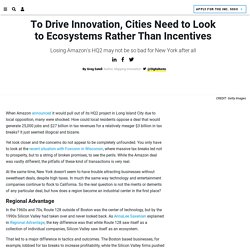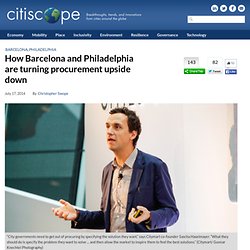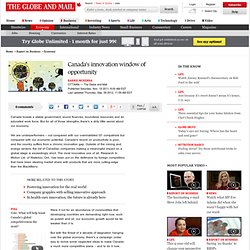

To Drive Innovation, Cities Need to Look to Ecosystems Rather Than Incentives. When Amazon announced it would pull out of its HQ2 project in Long Island City due to local opposition, many were shocked.

How could local residents oppose a deal that would generate 25,000 jobs and $27 billion in tax revenues for a relatively meager $3 billion in tax breaks? It just seemed illogical and bizarre. Yet look closer and the concerns do not appear to be completely unfounded. Tesla's Electric Domination Moves Forward With Debut of Beautiful Solar Shingles. In Cold Wyoming Winters, A New Vertical Farm Keeps Fresh Produce Local. Not Too Windy, Not Too Calm: Capturing Iceland's Winds. Stop Flushing Water Down the Drain [Excerpt] This Heated Road De-Ices Itself. These heated slabs can melt the snow right off the road, and although they cost quite a bit more than regular pavement, the use of industrial waste in their construction means that they’re not too pricey, either.

The gimmick here is that the concrete itself is conductive. When electricity runs through this concrete, it turns the whole road into a giant heater element. Forty eight volts is enough to power it, and if it is switched on before the snowstorm hits, the road surface is warm enough to stop snow settling in the first place. "When the snow hits, it melts instantly so you don't have any accumulations," says the concrete’s co-inventor Chris Tuan, from the University of Nebraska, Lincoln. The Inescapable Paradox of Managing Creativity. Executive Summary NOTE: Gretchen has the illustration, to be adapted for the piece.

When facing the challenge of unleashing organizational innovation, many leaders fail. Some attempt to help their teams flourish by granting almost unlimited freedoms, only to discover that they have created chaos, not high performance. Others try to force their employees’ creativity through prescribed programs and activities, which usually yields humdrum results at best. After studying proven masters at fostering organizational innovation for over ten years, we have identified the heart of the difficulty. What Can 'the Mystery' of Cell-Phone Data Tell Us About What a City Needs?
Most people are pretty attached to their phones.

Ninety percent of adults have one, and 78 percent of kids use one. As Aaron Reiss observes in his documentation of the cell phone storage industry in New York, cell phones are a huge part of our lives. How Barcelona and Philadelphia Are Turning Procurement Upside Down. New ideas are rare in the staid world of government contracting.

But in Barcelona, city contracts worth as little as €60,000 have entrepreneurs buzzing — and cities around the world watching to see who wins them. How the Internet of Things could change the US postal service. Data crunching can prevent cars from crashing. Having already cut traffic collisions resulting in injuries and deaths nearly 40 per cent in five years by analyzing patterns from data it has collected, the city of Edmonton is using predictive technologies to increase road safety even more.

As drivers navigate Edmonton’s streets, they will inevitably pass a digital messaging sign, one of as many as 200 strategically located throughout Alberta’s second-largest city. “On a day when there would be a high risk for collisions based on road conditions – really slippery or very cold temperatures – you would see a message advising, ‘Road conditions icy ahead,’ or that type of thing,” says Gerry Shimko, executive director of the City of Edmonton’s Office of Traffic Safety (OTS).
The digital signs are just one element of an innovative traffic safety program that has dramatically reduced vehicle collisions in the Edmonton region since OTS launched in late 2006. Underpinning this effort is data analytics. Mr. Mr. The Boeing Debacle: Seven Lessons Every CEO Must Learn. Peggy Noonan On Steve Jobs And Why Big Companies Die. Cities Focusing On Big Data And Mobility.
When it comes to technology and strategy, government is often behind the times, and far behind the most innovative businesses. Setting a course for innovation success. Canada’s innovation window of opportunity. Canada boasts a stable government, sound finances, boundless resources and an educated work force.

But for all of those strengths, there’s a dirty little secret about our economy. We are underperformers – not compared with our overindebted G7 compatriots but compared with our economic potential. Canada’s record on productivity is poor, and the country suffers from a chronic innovation gap. Outside of the mining and energy sectors, the list of Canadian companies making a meaningful impact on a global stage is exceedingly short. Innovation Cities Top 100 Index 2011: City Rankings » Innovation Cities Index & Program – City data training events from 2THINKNOW for USA Canada America Europe Asia Mid-East Australia. Top 100 world cities for an innovation economy in 2011.

The world’s largest city classification and ranking with 331 benchmark cities classified, and top 125 cities ranked in 2011, of which the top 100 are listed below. Based on 2thinknow analysis of cities in what our analysts term the ‘global innovation economy’. Annual since 2007. View current Media Release + Read the 2011 FAQ Key to index. All cities are graded into award categories based on their index score. NEXUS: Critical nexus for multiple economic and social innovation segments HUB: Dominance or influence on key economic and social innovation segments , based on global trends NODE: Broad performance across many innovation segments, with key imbalances.